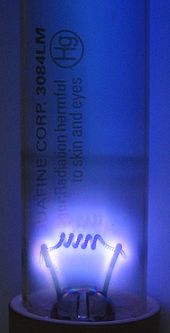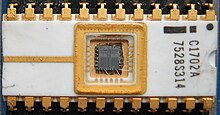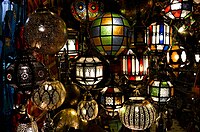Germicidal lamp
This article needs additional citations for verification. (July 2017) |



A germicidal lamp (also known as disinfection lamp or sterilizer lamp) is an
There are four common types available:
- Low-pressure mercury lamps
- High-pressure mercury lamps
- Excimer lamps
- LEDs
Low-pressure mercury lamps
Low-pressure mercury lamps are very similar to a fluorescent lamp, with a wavelength of 253.7 nm (1182.5 THz).
The most common form of germicidal lamp looks similar to an ordinary fluorescent lamp but the tube contains no fluorescent
An older design looks like an
As with all
High-pressure mercury lamps
High-pressure lamps are much more similar to
These lamps radiate a broad-band UVC radiation, rather than a single line. They are widely used in industrial water treatment, because they are very intense radiation sources. High-pressure lamps produce very bright bluish white light.
Excimer lamps
Light-emitting diodes (LEDs)
Recent developments in light-emitting diode (LED) technology have led to the commercial availability of UVC LED sources.
UVC LEDs use semiconductor materials to produce light in a solid-state device. The wavelength of emission is tuneable by adjusting the chemistry of the semiconductor material, giving a selectivity to the emission profile of the LED across, and beyond, the germicidal wavelength band. Advances in understanding and synthesis of the
The reduced size of LEDs opens up options for small reactor systems allowing point-of-use applications and integration into medical devices.[2] Low power consumption of semiconductors introduce UV disinfection systems that utilized small solar cells in remote or Third World applications.[2]
By 2019, LEDs made up 41.4% of UV light sales, up from 19.2% in 2014[3] The UV-C LED global market is expected to rise from $223m in 2017 to US$991m in 2023.[4]
Uses
Germicidal lamps are used to sterilize workspaces and tools used in biology laboratories and medical facilities. If the quartz envelope transmits shorter wavelengths, such as the 185 nm mercury emission line, they can also be used wherever

The light produced by germicidal lamps is also used to erase
Ozone production
For most purposes, ozone production would be a detrimental side effect of lamp operation. To prevent this, most germicidal lamps are treated to absorb the 185 nm mercury emission line (which is the longest wavelength of mercury light which will ionize oxygen).
In some cases (such as water sanitization), ozone production is precisely the point. This requires specialized lamps which do not have the surface treatment.
Safety concerns
Short-wave UV light is harmful to humans. In addition to causing
References
- ^ "Corning Vycor® 7913 UV-Transmitting Glass". www.matweb.com. Corning. Retrieved 3 December 2019.
- ^ .
- ^ "Technology – UV LED". Seoul Viosys. Retrieved 2020-04-09.
- ^ "Anti-bacterial UV-C LED applications driving stable growth in UV-LED market". Semiconductor Today. Retrieved 2020-04-09.
- ^ "Final Opinion". 2016-11-25.
External links
 Media related to Germicidal lamps at Wikimedia Commons
Media related to Germicidal lamps at Wikimedia Commons



